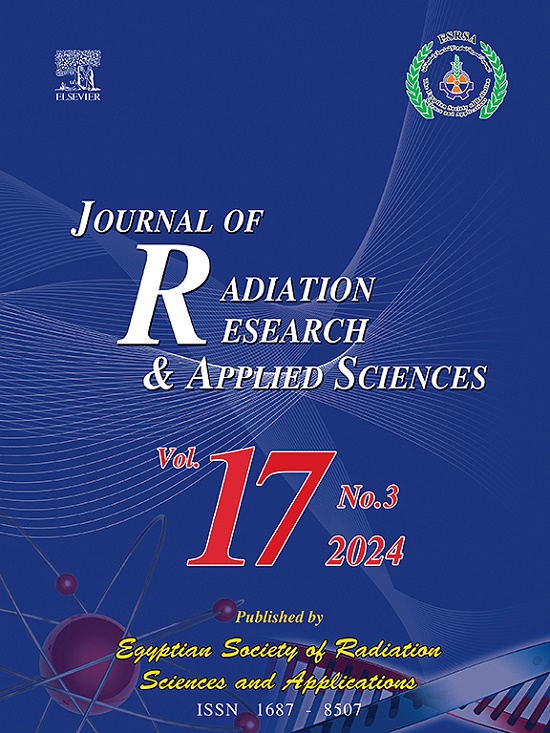Irreversibility analysis and thermal performance of quadratic radiation and Darcy-Forchheimer flow over non-isothermal needle with velocity slip: Effects of aggregation and non-aggregation dynamics
IF 1.7
4区 综合性期刊
Q2 MULTIDISCIPLINARY SCIENCES
Journal of Radiation Research and Applied Sciences
Pub Date : 2025-03-05
DOI:10.1016/j.jrras.2025.101395
引用次数: 0
Abstract
The importance of nanofluid flow across thin geometries in thermal engineering, biological applications, and energy systems has led to much research into this topic. Classical boundary layer theories first guided studies on heat transport across needles; subsequently, magnetohydrodynamic (MHD), porous media, radiation effects, and convective heat transfer processes were included. Although recent developments have brought nanoparticles to improve thermal conductivity, their behavior especially under aggregation and non-aggregation conditions remains a subject of much investigation. This study quantitatively analyses the flow, heat transfer, and entropy generation properties of nanofluid flow over a slender needle, accounting for the influences of an inclined magnetic field, quadratic thermal radiation, Darcy-Forchheimer porous media, heat generation/absorption, viscous dissipation, Joule heating, velocity slip, convective heating, and nanoparticle aggregation. By using the bvp4c solver inside MATLAB, the controlling nonlinear boundary layer equations may be resolved. Findings show that the velocity profile grows with velocity slip but shrinks with increasing magnetic field strength, porous medium resistance, Darcy-Forchheimer drag, and inclined angle owing to increased resistive forces. Thermal energy dissipation causes the temperature profile to rise with increasing Biot number (Bi) and Eckert (Ec) numbers. Stronger convective effects in non-aggregation scenarios provide greater entropy creation. Skin friction diminishes with rising magnetic field intensity, slip, porous resistance, and needle thickness; however, it escalates with elevated nanoparticle volume fractions. The Nusselt number increases with the radiation, and temperature ratio, whereas it decreases with the Eckert number and nanoparticle volume percentage. Heat absorption exceeds heat production by 16.51%–28.61% in the non-aggregation model and by 17.30%–29.03% in the aggregation model when Bi grows from 0.2 to 0.8. Heat absorption situations often provide greater heat transfer rates than heat production. The research shows that nanofluid properties, resistance of porous media, and MHD forces all interact intricately to determine thermal and flow parameters. The results provide the groundwork for future technical optimizations of cooling and thermal management systems based on nanofluids.
具有速度滑移的非等温针上二次辐射和Darcy-Forchheimer流动的不可逆性分析和热性能:聚集和非聚集动力学的影响
纳米流体在热工程、生物应用和能源系统中的重要性导致了对这一主题的大量研究。经典边界层理论首次指导了针间热输运研究;随后,包括磁流体动力学(MHD)、多孔介质、辐射效应和对流换热过程。尽管近年来纳米颗粒的发展改善了导热性,但其在聚集和非聚集条件下的行为仍有待进一步研究。考虑倾斜磁场、二次热辐射、达西-福希海默多孔介质、产热/吸收、粘性耗散、焦耳加热、速度滑移、对流加热和纳米颗粒聚集等因素的影响,本研究定量分析了纳米流体在细针上的流动、传热和熵产特性。利用MATLAB自带的bvp4c求解器,可以求解控制非线性边界层方程。结果表明:速度剖面随速度滑移增大而增大,但随磁场强度、多孔介质阻力、达西-福希海默阻力和倾斜角增大而减小。随着Biot数(Bi)和Eckert数(Ec)的增加,热耗散导致温度廓线升高。在非聚集情景中,更强的对流效应会产生更大的熵。表面摩擦力随着磁场强度、滑移、多孔阻力和针尖厚度的增加而减小;然而,它随着纳米颗粒体积分数的增加而升级。Nusselt数随辐射比和温度比的增大而增大,随Eckert数和纳米颗粒体积百分比的增大而减小。当Bi从0.2增大到0.8时,在非聚集模型中吸热比产热大16.51% ~ 28.61%,在聚集模型中吸热比产热大17.30% ~ 29.03%。吸热情况通常比产热情况提供更大的传热速率。研究表明,纳米流体的性质、多孔介质的阻力和MHD力相互作用,决定了热和流动参数。研究结果为未来基于纳米流体的冷却和热管理系统的技术优化奠定了基础。
本文章由计算机程序翻译,如有差异,请以英文原文为准。
求助全文
约1分钟内获得全文
求助全文
来源期刊

Journal of Radiation Research and Applied Sciences
MULTIDISCIPLINARY SCIENCES-
自引率
5.90%
发文量
130
审稿时长
16 weeks
期刊介绍:
Journal of Radiation Research and Applied Sciences provides a high quality medium for the publication of substantial, original and scientific and technological papers on the development and applications of nuclear, radiation and isotopes in biology, medicine, drugs, biochemistry, microbiology, agriculture, entomology, food technology, chemistry, physics, solid states, engineering, environmental and applied sciences.
 求助内容:
求助内容: 应助结果提醒方式:
应助结果提醒方式:


